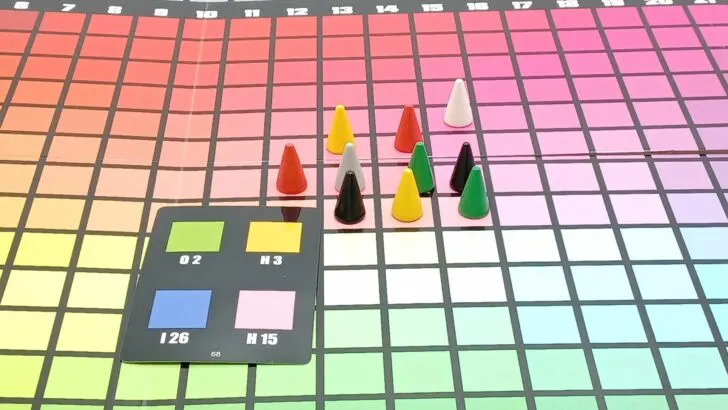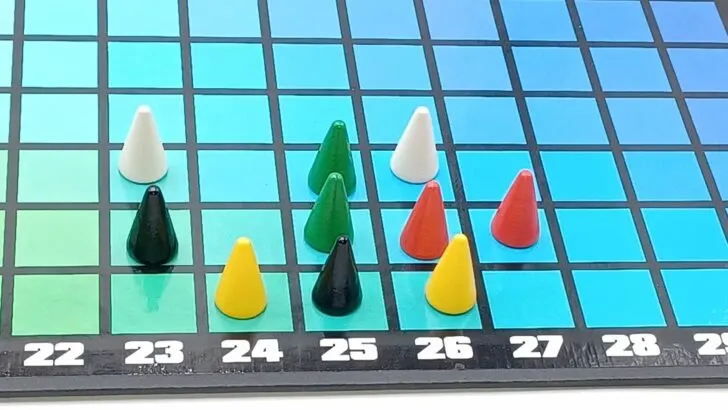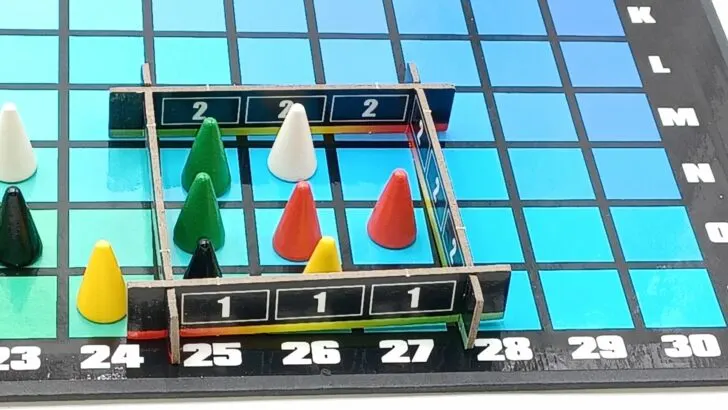Objective of Hues and Cues
The objective of Hues and Cues is to score more points than the other players by giving good color cues, and figuring out the other players’ cues.
Setup for Hues and Cues
- Place the gameboard in the center of the table.
- Each player chooses a color of playing pieces. You will take the three pieces of the color you chose.
- You will place one of your three pieces to the left of the score track. You will keep the other two pieces in front of you.
- Shuffle the cards and place them face down on the table to form a draw pile.
- Assemble the scoring frame and set it to the side of the gameboard.
- The player who is wearing the most colorful outfit will be the first cue giver.
Playing Hues and Cues
Hues and Cues is played over a number of rounds. The number of rounds depends on the number of players. If there are three to six players, each player will be the cue giver twice. If there are seven or more players, each player will be the cue giver once.
Each round of Hues and Cues consists of six stages.
- Draw A Card
- One-Word Cue
- First Guess
- Two-Word Cue
- Second Guess
- Scoring
Drawing A Card
To start each round the current cue giver draws the top card from the draw pile. They will look at the card making sure none of the other players see it.
On the card there will be four different colors and coordinates. The coordinates help you find the color on the gameboard. The cue giver will choose one of the four colors that they will use for the round.
To make the game easier for younger players, you can choose to use a variant rule. Instead of drawing a card, the players will choose any color they want from the gameboard. This allows players to choose a color that they can give better cues for. The player should write down the coordinates of the color they chose.
One-Word Cue
After choosing the color that they will use for the round, the cue giver has to try and come up with a one-word cue to describe the color they chose.

They may choose any word they want to describe the color with a few exceptions.
You cannot use any of the following colors for your cue:
- black
- blue
- brown
- gray
- green
- orange
- pink
- purple
- red
- white
- yellow
You may use more abstract color names for your cue though. This includes colors such as lavender.

You may not use a cue that references the color’s position on the gameboard. This means you can’t use a cue referencing the color’s letter or number.
You cannot compare the color to an object in the room where you are playing the game.
Finally you cannot repeat a cue used earlier in the game.
First Guess
After the cue giver gives the one-word cue, all of the other players will get the opportunity to make their first guess.
Starting with the player to the left/clockwise of the cue giver, each player takes one of their pieces and places it on one of the spaces on the gameboard. You should place your piece on a space that you think the cue giver was describing with their cue.

Only one piece can be placed on each space.

Two-Word Cue
Once all of the other players have made their first guess, the cue giver provides a second cue. This cue can consist of one or two words.
When giving this second cue you must follow all of the rules from the first cue.
Additionally you cannot use words in reference to the players’ first guesses in order to direct them to a different part of the gameboard. For example you can’t give the cues “lighter” or “darker” to suggest they should make their second guess a color that is lighter or darker than their first guess.
If the cue giver is happy with the number of pieces placed in the scoring zone from their first cue, they can choose to skip their second cue. If they choose to skip the second cue, the other players do not get to make a second guess.
Second Guesses
After the cue giver gives their second cue, the other players get to place their remaining piece on the gameboard.

You can place your second piece on any space on the gameboard that doesn’t already have another piece on it.

Scoring in Hues and Cues
After all of the players have placed their second guess on the board, the game proceeds to scoring.
The cue giver reveals the color to the other players by announcing its coordinate letter and number. They will then place the scoring frame on the gameboard. You should place the scoring frame so the color for the round is in the center of the square.
Players will then tally the amount of points they scored in the round. You will move your scoring track piece forward on the track a number of spaces equal to the number of points that you scored.
Cue Giver Scoring
First the cue giver receives one point for each piece that was placed within the scoring frame. In three player games they will score two points for each piece in the scoring frame. The cue giver can score a maximum of nine points on their turn.
Guessers Scoring
Each player then scores the two pieces they placed on the gameboard. They will score points based on where their pieces are located in relation to the color for the round.
If you guess the exact same space as the color for the round, you receive three points for that piece.
Should your piece be inside the scoring frame but is not the exact color, you will receive two points for it.
Finally if your piece touches the outside of the scoring frame (it is just outside of the scoring frame), you will score one point for the piece. This includes pieces that diagonally touch the outside of the scoring frame.
Players can score points for both of their pieces placed during a round. Guessers can score a maximum of five points on their turn.
Scoring Examples



Starting A New Round
To prepare for the next round, each player takes their pieces from the gameboard (not the scoring track). The player to the left/clockwise of the previous cue giver, becomes the cue giver for the next round. They will draw a new card for their round.
Winning Hues and Cues
Hues and Cues ends when each player has been the cue giver the correct number of rounds.
- 3-6 players: Two times each player
- 7+ players: One time each player
At this point the players will compare their scores. The player that has scored the most points wins the game.

If there is a tie, you will play additional rounds until one of the tied players take the lead by themselves. In these additional rounds the tied players cannot be the cue giver.

Year: 2020 | Publisher: The Op | Designer: Scott Brady
Genres: Deduction, Party
Ages: 8+ | Number of Players: 3-10 | Length of Game: 30 minutes
Difficulty: Light | Strategy: Light-Moderate | Luck: Moderate
Components: Game Board, 100 cards, 30 Player Pieces, Scoring Frame, Instructions
Where to Purchase: Amazon, eBay Any purchases made through these links (including other products) help keep Geeky Hobbies running. Thank you for your support.
For more board and card game how to plays/rules and reviews, check out our complete alphabetical list of board game posts.

